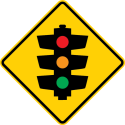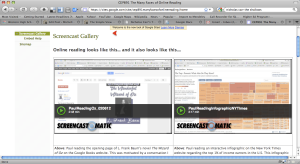![]() Lately, I’ve been asked by several teacher colleagues for information that could help them understand the complexities of digital literacies, and by extension, digital literacies instruction.
Lately, I’ve been asked by several teacher colleagues for information that could help them understand the complexities of digital literacies, and by extension, digital literacies instruction.
I’ve decided to begin posting my responses to my colleagues on my blog, in case there are others who could benefit from these thoughts.
I also welcome input from others who could inform answers to these questions!
Here’s the first question.
“I have a question from our Foreign language department chair. Have you found any research on the advantages of reading/writing online vs. reading print (and writing by hand). These teachers feel that in their field the writing by hand is so crucial to learning the language. Thank you if you know of any research specific to learning languages and online vs print reading/writing.”
Here’s how I responded:
In response to your question, here are my thoughts. I do have some research to share — but first, a synthesis of my understanding that could inform your colleagues’ thinking.
1) Language learning is a complex socio-cognitive process that requires vast and varied opportunities for both comprehensible input, but also output. Work by second language scholars such as Stephen Krashen, Merrill Swain and Sharon Lapkin has told us that input and output are essential. And it makes sense, doesn’t it? Opportunities to receive and understand language, but also opportunities to produce language and communicate ideas are obviously essential for the learning of any language. Moreover, the input and the output must take many forms — oral language (input and output) and written language (input and output). Plus, we know that for our students to become confident, fluent communicators, they need access to multiple types of input and output that serve a range of rhetorical purposes and force an understanding of a range of audiences. So, students need to read texts that inform, persuade, describe, narrate etc. and also create these texts. In the 21st century, this needs to occur in digital contexts too. This is because we know that the structures of online texts differ, and that the skills required to produce digital texts for a range of purposes and audiences are different than those acquired through print-based or even face-to-face exchanges. If your colleagues are worried about the digital world taking over — do assure them that traditional, print-based contexts for input and output matter a LOT. Learning to read, write and communicate in the “traditional” ways is as important as ever — and even, perhaps foundational for the development of digital literacies skills. However, it’s my view that to deny students opportunities and access to digital composition is also to deny them opportunities to use language for a variety of purposes and in a variety of contexts that are absolutely essential to their futures as citizens in a world that is becoming increasingly networked.
2) Human beings learn everything by interacting with, and acting on, their world. To do this, we use all of our sensory faculties — we hear, we see, we touch, we manipulate, we smell. Increasingly, we understand learning as an embodied experience — so that what our bodies do, how they are oriented in space, and how they interact with the context of our learning or activity, is now understood to matter quite a lot. The tools we use, the places in which we use them, and the feelings and senses we have as we use these tools in context are all inextricably connected to the thinking and learning we do. Scholars like Andy Clark, Arthur Glenberg, and Kevin Leander have helped us to understand the ways that learning and literacies are, in fact, embodied. This is the theoretical foundation for the gesture approach to L2 learning championed by Wendy Maxwell http://aimlanguagelearning.com
Okay — so given this, we must also acknowledge that we process and manipulate information in our brains. The extent to which we integrate the information that reaches our brains depends on a lot of factors — but to address the factors related to your colleagues’ assertions about the importance of writing with pens/pencils vs. typing — I can say that there is probably some truth in their observations because writing with pens/pencils engages multiple sensory channels. And, the more channels are engaged, the more information is coming in to our brains to be processed. So, writing involves holding a pen, moving it in certain ways to produce letters that are then seen/read. Some students might even say the words aloud as they write them — so there are two more modalities engaged — the ears and the voice.
3) Moreover, for young learners, the written page is a defined space that is clear of distraction. And, for cognitively demanding work — like learning another language — we know that distractions reduce our ability to attend to important details. The more we have going on in our environment (i.e., on the Internet) the more our attention will be divided. So, the observations that your colleagues have made may be as much about creating an optimal environment for undivided attention as anything.
4) I would say to your colleagues that they should not think of online vs. print-based literacies (L1 or L2) as being in tension or in opposition with one another. Rather, given the importance of digital literacies, we should think about providing students with a range of opportunities to develop all of the necessary literacies skills/mindsets/dispositions that will enable them to be fully engaged global citizens.It’s not a question of one context being better for learning than another. Rather, it’s about understanding the multiple contexts that our students will need to navigate and ensuring that they’re ready to do that. If anyone can help our students to do this — it’s the Modern/Foreign Language teachers. These are the colleagues who understand culture, who understand the complexities and multiplicities of meaning, who think in multiple sign systems all day, every day. In fact, I believe that the Foreign Language classroom is precisely where kids gain an understanding of the ways that meaning can be communicated that translate, actually, to the multimodal environments they meet online. Foreign language teachers have always, for instance, helped students to leverage images in ways that support meaning. Online, that’s an absolutely necessary skill because there are so many visual cues that communicate meaning.
References I shared:
Castañeda, D.A. & Cho, M-H.(2013).The role of wiki writing in learning Spanish grammar. Computer Assisted Language Learning, 26(4), 334-349. doi:http://dx.doi.org/10.1080/09588221.2012.6
Kern, R. (2014). Technology as pharmakon: The promise and perils of the Internet for foreign language education. The Modern Language Journal, 98(1), 340-357. doi: 10.1111/j.1540-4781.2014.12065.x
0026-7902/14/340–357
I also recommended that these colleagues regularly consult The Reading Teacher, The Journal of Adolescent and Adult Literacy, The Modern Language Journal and Computer Assisted Language Learning for research findings to inform their work.
Photo reference: Wilke, S. (2009). Black and white icon of a question mark. Retrieved from http://commons.wikimedia.org/wiki/File:Icon-round-Question_mark.jpg. Used under author licensing to reuse the image “for any purpose without conditions”.

